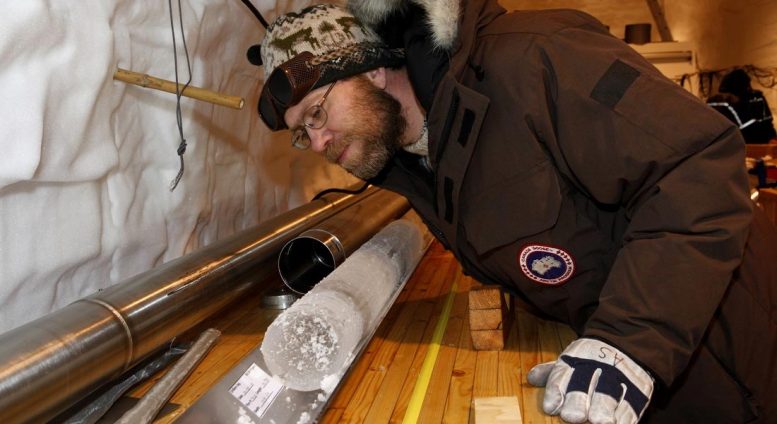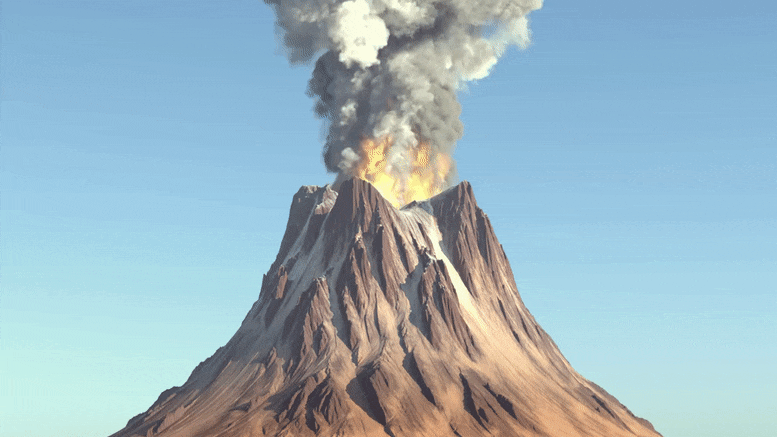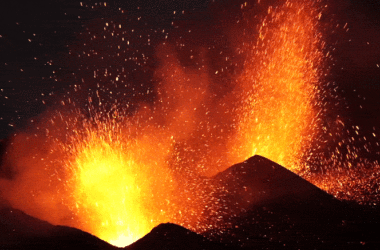Des carottes de glace prélevées en Antarctique et au Groenland ont révélé des éruptions volcaniques gigantesques au cours de la dernière période glaciaire. Soixante-neuf d’entre elles étaient plus importantes que toutes les éruptions de l’histoire moderne. Selon les physiciens de l’université de Copenhague à l’origine de ces recherches, ces éruptions peuvent nous renseigner sur la sensibilité de notre planète au changement climatique.
Pour beaucoup de gens, l’évocation d’une éruption volcanique évoque des scénarios apocalyptiques, avec des explosions assourdissantes, des cendres noires s’élevant dans la stratosphère et de la lave gluante ensevelissant tout sur son passage, tandis que des personnes paniquées courent pour sauver leur vie. Alors qu’une telle éruption pourrait théoriquement se produire demain, nous avons dû nous contenter de films et de livres sur les catastrophes lorsqu’il s’est agi d’éruptions volcaniques vraiment massives dans l’ère moderne.
“Nous n’avons connu aucune des plus grandes éruptions volcaniques de l’histoire. Nous pouvons le constater maintenant. L’Eyjafjellajökull, qui a paralysé le trafic aérien européen en 2010, n’est rien en comparaison des éruptions que nous avons identifiées plus loin dans le temps. Nombre d’entre elles étaient plus importantes que toutes les éruptions des 2 500 dernières années”, explique le professeur associé Anders Svensson, de l’Institut Niels Bohr de l’université de Copenhague.
En comparant des carottes de glace prélevées en Antarctique et au Groenland, Anders Svensson et ses collègues chercheurs ont réussi à estimer la quantité et l’intensité des éruptions volcaniques au cours des 60 000 dernières années. Jusqu’à présent, les estimations des éruptions volcaniques survenues il y a plus de 2 500 ans étaient associées à une grande incertitude et à un manque de précision.
Fiche d’information : Sélection d’éruptions volcaniques connues
Les éruptions volcaniques sont classées en fonction de leur taille selon l’indice d’explosivité volcanique (VEI), qui va de 1 à 8.
- Etna, Italie (1669) : 3 sur l’échelle VEI.
- Eyjafjellajökul, Islande (2010) : 4 sur l’échelle VEI.
- Vésuve, Italie (année 79) : 5 sur l’échelle VEI.
- Laki, Islande (1783) : 6 sur l’échelle VEI.
- Krakatau, Indonésie (1883) : 6 sur l’échelle VEI.
- Tambora, Indonésie (1815) : 7 sur l’échelle VEI.
- Lac Taupo, Nouvelle-Zélande (il y a 26 500 ans) : 8 sur l’échelle VEI.
- Toba, Indonésie (il y a 74 000 ans) : 8 sur l’échelle VEI.
Soixante-neuf éruptions plus importantes que le Mont Tambora.
Quatre-vingt-cinq des éruptions volcaniques identifiées par les chercheurs étaient de grandes éruptions mondiales. On estime que soixante-neuf d’entre elles sont plus importantes que l’éruption du mont Tambora en Indonésie en 1815 – la plus grande éruption volcanique de l’histoire humaine enregistrée. Tant de sulfurique acid was ejected into the stratosphere by the Tambora eruption that it blocked sunlight and caused global cooling in the years that followed. The eruption also caused tsunamis, drought, famine, and at least 80,000 deaths.
“To reconstruct ancient volcanic eruptions, ice cores offer a few advantages over other methods. Whenever a really large eruption occurs, sulfuric acid is ejected into the upper atmosphere, which is then distributed globally – including onto Greenland and Antarctica. We can estimate the size of an eruption by looking at the amount of sulfuric acid that has fallen,” explains Anders Svensson.
In a previous study, the researchers managed to synchronize ice cores from Antarctica and Greenland – i.e., to date the respective core layers on the same time scale. By doing so, they were able to compare sulfur residues in ice and deduce when sulfuric acid spread to both poles after globally significant eruptions.

Anders Svensson inspecting an icecore in Greenland. Credit: NEEM
When will it happen again?
“The new 60,000-year timeline of volcanic eruptions supplies us with better statistics than ever before. Now we can see that many more of these great eruptions occurred during the prehistoric Ice Age than in modern times. Because large eruptions are relatively rare, a long timeline is needed to know when they occur. That is what we now have,” says Anders Svensson.
One may be left wondering when the next of these massive eruptions will occur. But Svensson isn’t ready to make any concrete predictions:
“Three eruptions of the largest known category occurred during the entire period we studied, so-called VEI-8 eruptions (see fact box). So, we can expect more at some point, but we just don’t know if that will be in a hundred or a few thousand years. Tambora-sized eruptions appears to erupt once or twice every thousand years, so the wait for that may be shorter.”
How was climate affected?
When powerful enough, volcanic eruptions can affect global climate, where there is typically a 5-10- year period of cooling. As such, there is great interest in mapping the major eruptions of the past – as they can help us look into the future.
“Ice cores contain information about temperatures before and after the eruptions, which allows us to calculate the effect on climate. As large eruptions tell us a lot about how sensitive our planet is to changes in the climate system, they can be useful for climate predictions,” explains Anders Svensson.
Determining Earth’s climate sensitivity is an Achilles heel of current climate models. Svensson concludes:
“The current IPCC models do not have a firm grasp of climate sensitivity – i.e., what the effect of a doubling of CO2 in the atmosphere will be. Vulcanism can supply us with answers as to how much temperature changes when Earth’s atmospheric radiation budget changes, whether due to CO2 or a blanket of sulfur particles. So, when we have estimated the effects of large volcanic eruptions on climate, we will be able to use the result to improve climate models.”
In all, the researchers identified 1,113 volcanic eruptions in Greenlandic ice cores and 740 eruptions in Antarctic ice cores over the past 60,000 years, where cores had sulfuric acid deposits greater than 20kg and 10kg per square kilometer, respectively.
Eighty-five of the eruptions identified were observed by researchers at both of Earth’s poles. Twenty-five of these were larger than any eruption in the past 2,500 years, while 69 were larger than the 1815 Tambora eruption, the largest volcanic eruption on record in the last 500 years.
Their recent study is published in the journal, Climate of the Past.
Reference: “Magnitude, frequency and climate forcing of global volcanism during the last glacial period as seen in Greenland and Antarctic ice cores (60–9 ka)” by Jiamei Lin, Anders Svensson, Christine S. Hvidberg, Johannes Lohmann, Steffen Kristiansen, Dorthe Dahl-Jensen, Jørgen Peder Steffensen, Sune Olander Rasmussen, Eliza Cook, Helle Astrid Kjær, Bo M. Vinther, Hubertus Fischer, Thomas Stocker, Michael Sigl, Matthias Bigler, Mirko Severi, Rita Traversi and Robert Mulvaney, 15 March 2022, Climate of the Past.
DOI: 10.5194/cp-18-485-2022
The researchers who contributed to the study are: Jiamei Lin, Anders Svensson, Christine S. Hvidberg, Johannes Lohmann, Steffen Kristiansen, Dorthe Dahl-Jensen, Jørgen P. Steffensen, Sune O. Rasmussen, Eliza Cook, Helle Astrid Kjær and Bo M. Vinther from the Niels Bohr Institute at the University of Copenhagen; Hubertus Fischer, Thomas Stocker, Michael Sigl and Matthias Bigler of the University of Bern, Switzerland; Mirko Severi and Rita Traversi of the University of Florence in Italy and Robert Mulvaney of the British Antarctic Survey in the UK.



